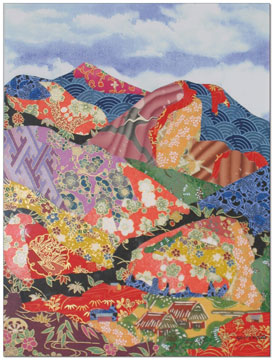|
| ||||
| Passion on paper
by Jules Masterjohn When we think of dynamic duos in the visual arts, the names of Frida Kahlo and Diego Rivera, Georgia O’Keeffe and Alfred Stieglitz, and Christo and Jeanne-Claude surge to mind. Whether working collaboratively or on separate, individual careers, the merging of domestic lives and art professions can be highly stimulating. O’Keeffe remarked in a documentary film that the reason she and Stieglitz were able to stay together for 28 years, despite differences in temperament, lifestyle and locale, was that they were “interested in what each other was doing (artistically)…very interested.” New Agers might call these couples soulmates. A more apt term, perhaps, is artmates. Regardless of what name is applied, finding a deepened sense of purpose through the commingling of daily routine and artistic passion is true for New Mexican artists Bunny Tobias and Charles Greeley. A couple in life and art for more than 45 years, the two visited Durango last weekend to open their exhibit, “Paper & Clay,” in the Art Library at the Durango Arts Center. Local artist Louise Grunewald, who met Tobias and Greeley years ago while she was living in New Mexico, suggested the couple’s work as part of the out-of-town series by F.O.A.L. – Friends of the Art Library. The group presents smallish and inventive work by artists from elsewhere as a complement to the local artists that also show in the alternative venue. “It seemed like their work would suit the library, and I figured that people in Durango wouldn’t get to know them unless they came here,” offered Grunewald. “I’ve always been intrigued by husband and wife teams that support each other in their work. The work presented in this show is the tip of their artistic iceberg.” It is clear from viewing “Paper & Clay” that Tobias and Greeley are well accomplished artists. Also obvious is their knack for making an elegant display. Hanging art is second nature for them – since 1996, they have owned and run Gallery ZIPP (Zen Inspired Professional Pagans), a contemporary art gallery in Glorieta, N.M. It is here in their 250-year-old adobe hacienda where they live, create, and exhibit. The two understand how to present art for the ease and interest of the viewer, which is an art form in itself. Order and simplicity fill the Art Library, along with each of their individual collages, as well as Tobias’ ceramic vessels and mixed-media works. Though the exhibit draws attention to paper and clay, their collage work is also noteworthy. Surprisingly, they did not learncollage in art school: these techniques and processes were learned in life. Both graduated in 1963 from the New York School of Visual Arts, which is where they met. Tobias recalls, “We studied painting, sculpture, printmaking, drawing. Never collage. No one taught how to tear, cut, layer or paste papers or mixed-media material. It was too amusing, not enough structure, ephemeral – the very reasons that collage is so appealing.” While Greeley uses intricately patterned and vividly colored papers to create “imaginary” landscapes based on actual locations, Tobias uses reproductions of historical engravings and vintage photographic images to construct her “fantastic and surreal” worlds. Different in style and yet similar in intention, Tobias and Greeley set out to explore and express “alternative realities.” The medium of collage lends itself perfectly to this goal. The techniques of layering paper and juxtaposing imagery used in collage making can be seen as metaphoric processes for the “hidden mysteries and secret languages” of consciousness, as visual poetry expressing the syntax of the psyche. Greeley reveals the energetic interconnection of earth’s topography and the flora and fauna that inhabit it, through his casual use of compositional elements like scale, value, color and pattern. In his small collages, like “Taos Mountains,” he has made visible the vibration of the natural world, merging what is seen (the outer landscape) with what is felt (the inner perception.) In his words, “I’ve continued my pantheistic genre of creating visionary landscapes and collage with Japanese paper cut into miniscule shapes that, when seen together, form a luminous whole.” The landscape of the unconscious mind is exposed in Tobias’ collage work, as are her feminist leanings. Psychological and dreamlike, her “Making Waves” series is an exposé on feminine freedom and passion. Her female figures irreverently disregard the laws of nature and men. They comfortably float, swim and fly and in every way cavort with the forces of nature. These are images of ecstasy unleashed, linking female potency to the power of the natural world. Symbolism is the prime vehicle of expression and aligns Tobias with the best of the Surrealists. In her constructed world, it is no wonder that the few male figures appear alarmed: patriarchy has lost its control. How exhilarating! Tobias’ work and words remind us of the importance of passion and commitment – to self, to another and to art. “Our life together, as artists and partners, has been inspired and blessed as a result of following the direction of our dreams.” • “Paper & Clay” is on display in the Art Library upstairs at the Durango Arts Center, 802 E. Second Ave., through October. Hours are 10 a.m.-5 p.m., Monday through Saturday.
|
In this week's issue...
- May 15, 2025
- End of the trail
Despite tariff pause, Colorado bike company can’t hang on through supply chain chaos
- May 8, 2025
- Shared pain
Dismal trend highlights need to cut usage in Upper Basin, too
- April 24, 2025
- A tale of two bills
Nuclear gets all the hype, but optimizing infrastructure will have bigger impact


